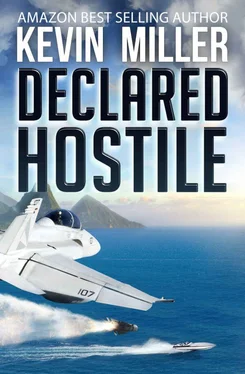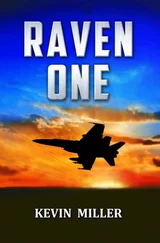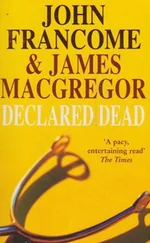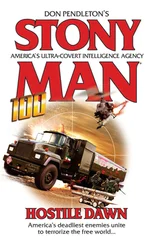At the moment Hernandez finished his report, he learned of American attacks on the capital. The Chief of Staff ripped into him, asking Hernandez if he could hear the sirens and thumps of American ordnance through the phone line, blaming him for the inept performance of the AMV in defending the Bolivarian Republic from attack. How could he accuse Hernandez of not defending the Bolivarian Republic? One of the American aircraft carriers was more than twice as powerful as the entire AMV! He didn’t deserve blame for this mismatch. Generals always blamed everyone but themselves. But, on a higher level, Hernandez knew he deserved it. If he were in Caracas, he would have already been cashiered — or worse. One way or another, he had only days to live, Hernandez knew he must now be one of those who got into the cockpit of a Viper being trucked to a dispersal field and attempt takeoff on a narrow highway strip. If he survived that, the flight controllers would vector him to a one-way meeting with an American formation that could out-stick him with missiles and flood his sensors with electronic jamming such that he would have no idea what was going on. At least he would die with a shard of honor.
Unless he could deliver the downed pilot, alive. That prize, and Daniel’s help, could save him. Once his report to Caracas was concluded, he ripped into his subordinates. Finding the American pilot alive was job one, and to make a point, he removed his sidearm and discharged it into the ceiling. He now had the full attention of his astonished and fearful staff, and they set out with renewed vigor — one group to find the American, the other to disperse the intact assets of San Ramón.
* * *
Aboard Coral Sea , Admiral Davies was waiting for LTJG Webb in CVIC. It was nearing midnight, and Kid had already boltered on his first pass before getting aboard with a lucky 4-wire on his next attempt. The recovery of the first strike was winding down, and the jets from the second wave would be here in an hour or so. Coral Sea was pitching and rolling as much as the new guys had ever seen, and it was black outside. Davies knew they had to go back tomorrow night and wondered if the untested aviators in Carrier Air Wing SIX were up to it.
CAG Matson and DCAG Kay also waited with Davies, who was becoming impatient.
“He trapped ten minutes ago. Where the hell is he?” Devil snapped at Matson.
Without being told, Kay picked up the J-dial phone and contacted Webb’s squadron, the Hells Angels of VFA-54 in Ready 6. He was waiting for an answer but cradled the receiver when the young pilot walked in still wearing flight gear that reeked of perspiration. Kid’s hair was matted down with sweat, and mask lines etched his face as he hoisted his helmet bag. Seeing the heavies when he walked into CVIC — all of them looking at him — caused his night-adapted eyes to open wide even in the bright fluorescent light. Matson spoke first.
“Admiral, this is Lieutenant JG Webb.”
Davies took two steps toward him. “Where have you been, son?”
A nervous Kid answered, breathing through his mouth. “They shut me down at the top of the bow, sir. I came here straight from the flight deck.”
“Okay, did you see Skipper Wilson get out?”
“I think so, sir. Coming off target, I saw a Hornet , lights out, in the teens, heading northeast. I was maybe a mile away from it when we were approaching the coast. It was rolling… weird, like barrel rolls, not jinks. I think it was on fire someplace aft. Then, it started a pretty steep descent, and soon there were two flashes. I think it was breaking up, and there was a trail of fire as it went in.”
Matson nodded, visualizing the ejection seat sequence and the parachute opening. “Sounds like the first flash was the motor of the seat rocket firing and the second the parachute spreader gun. You were on goggles?”
“Yes, sir. I was turning toward it.”
“What altitude was it?” Davies asked.
“I’d say low teens, sir.”
“Where?”
Kid studied at the chart of Venezuela on the planning table and pointed. “We were about here, sir, coasting out feet wet. DCAG led us east around a storm, then north along the line we had to punch through on the ingress.”
“Where you hit by lightning?” DCAG asked him.
“No, sir, but I was on Mikey’s wing, and I think he was. My whole fuckin’ field of view lit up. Ah, sorry, sir!” Kid answered, embarrassed that he let loose with a profanity in front of the admiral.
“No worries,” Davies said as he concentrated on the chart. The area pointed out by the nugget pilot was in a marshy flat covered in mangroves. A little spit of land led into the Columbus Channel, an area full of tiny estuaries. Satellite imagery confirmed it was little more than glorified swampland, and a downed aviator would have a challenge surviving in it, much less evading a determined enemy.
“Let’s see your tape,” CAG said. When Kid retrieved it, Commander Hofmeister took it to a nearby monitor to play for the admiral.
The grainy, green infrared image of San Ramón came into view. Kid’s aimpoint was on the taxiway, and the men watched as he slewed his diamond over it. In the background, they could hear clipped transmissions from the other strikers, including Wilson’s “in” call. The picture built frame by frame, and as the runway complex came into greater focus, they could make out small blips of light crossing the screen left to right — AAA.
“Was the AAA heavy?” CAG asked him.
“Don’t know, sir,” the young pilot replied. “Never seen it before.” His response caused the senior aviators to smile.
The image rotated as the aircraft rolled in, and rows of impact explosions erupted on the runways from the bombs of the Slash 11 and 21 divisions. Runway 28R had three cuts across it, not four. Wilson’s aimpoint was missing, evidence that he didn’t get his bombs off — at least not on target. Minutes passed as they watched the tape. They heard Wilson’s strained MAYDAY call, then nothing. DCAG gave a summary.
“Admiral, I was down the chute behind Flip, and while I was concentrating on my aimpoint, on the pull off he just wasn’t there. No flashes from AAA hits, and no evidence of impacts from his bombs. Kid here saw a Hornet on the egress—”
“Are you sure it was a Hornet ?” Davies queried, eyes narrowed.
“Yes, sir. Twin vertical stabs.”
“And you saw him get out?”
“Yes, sir, I think so, right next to a thunder cell. But I couldn’t make out a chute.”
“Have you seen an ejection before? On goggles? Ever?”
Kid held his gaze. “No, sir.”
“Could you have seen an airplane exploding?” Davies continued, unconvinced.
“Could be, sir.”
CAG stepped in. “Kid, thanks. Great job tonight. You get out of your gear, and we’ll see you in the debrief. Thanks.” After the lieutenant departed, he turned to Davies.
“Admiral, we heard Flip on GUARD reporting a total electrical failure and switching to the squadron tactical frequency. While circumstantial, it seems something happened to him over the target area, and he was trying to fly the jet over the water.
“Maybe the frickin’ Venezuelans were spoofing us.”
“Sir, the strikers, including Not-o here, recognized Flip’s voice, and he said he was switching to squadron tac. The enemy isn’t going to know that frequency, not a minute after he goes lights out. We also have a fellow aviator who saw a struggling Hornet on the egress and light patterns that indicate an ejection.”
Davies shot back. “Dammit, Matson, that boy can barely shave!” Matson stood his ground.
Читать дальше












